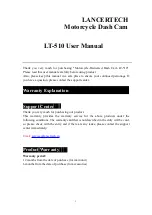
82
ķ
The setting range extends in the manual flash mode M from P 1/1 (full light
output) to P1/256 in one-third increments. In stroboscopic flash mode the
maximum adjustable partial light output can be adjusted to the flash parame-
ters.
In stroboscopic flash mode the reduction of the manual partial light
output is only possible in complete steps!
Setting procedure see cap. 7.
7.6 Stroboscopic flash number (N)
In stroboscopic flash mode the flash number (N) per shutter release can be set.
The number of flashes can be set from 1 to 50 in single increments. The
maximum possible manual partial light output is adjusted automatically at
the same time.
Setting procedure see cap. 7.
7.7 Stroboscopic flash frequency (f)
In the stroboscopic flash mode the flash frequency (f) can be selected. The
flash frequency indicates the number of flashes per second.
The flash frequency can be selected from 1 to 50 in single increments. The
maximum possible manual partial light output is adjusted automatically at
the same time.
Setting procedure see cap. 7.
8. Special function (Select menu)
The special functions are selected with the button “Sel” (Select). Depending
on the camera system (manufacturer), camera type and SCA adapter,
various special functions can be selected.
Setting procedure
• Press the button “SEL” repeatedly until “Select” appears in the display.
• Select the menu point or special function required with the Up / Down but-
tons
. The menu point selected will be highlighted with a dark bar.
• Press the button “Set” and so confirm the choice of the special function.
☞
• Enter the required setting with the Up / Down buttons
. The setting
takes effect immediately.
• Press the button “Return”
repeatedly until the normal display is
shown. If the button “Return”
is not pressed, the display will automati-
cally return to its normal appearance after approx. 5 seconds.
8.1 Bleep function (bleep)
With the bleep function the user can have some device functions of the flash
unit conveyed acoustically. In this way the photographer can concentrate fully
on the subject and shot and need not pay attention to additional optical sta-
tus displays!
The bleep function acoustically indicates when the flash is ready, the correct
flash exposure or an incorrect setting.
Acoustic signal after the flash unit is switched on:
• A short (approx. 2 second) uninterrupted bleep signal after switching on
indicates the flash readiness of the flash unit.
Bleep signal after shooting:
• A short (approx. 2 second) uninterrupted bleep signal immediately after
the shot indicates that the latter was correctly exposed and that flash readi-
ness remains available. If no bleep signal immediately follows the shot, the
photograph was under-exposed.
• An intermittent bleep signal immediately after the shooting is the signal for
a correctly exposed flash light shot. The flash readiness continues, but only
after a subsequent (approx. 2 second) continuous tone (bleep).
Bleep signals in the automatic flash mode:
• A short bleep as an acoustic alarm is generated in the auto flash mode if the
aperture and ISO setting would exceed the permissible light control range.
The auto aperture is automatically adjusted to the next permissible value.
With the bleep function switched on the symbol is additionally
shown in the display.
Setting procedure see cap. 8.
☞
705 47 0041.A4 76MZ-5 digital 15.03.2007 8:28 Uhr Seite 82
















































